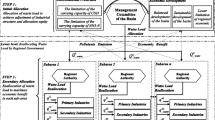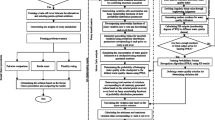Abstract
The practice of waste-load allocation in water quality management involves several noncommensurate and conflicting objectives. In particular, the objectives considered in this multiobjective stochastic waste-load allocation study are (1) maximization of total waste discharge, (2) maximization of instream dissolved oxygen concentration, (3) minimization of difference in equity measures, and (4) maximization of reliability of water quality compliance. To demonstrate the analysis, the model was applied to an example involving six waste dischargers.
Similar content being viewed by others
References
Brill, E., Liebman, J., and ReVelle, C., 1976, Equity measures for exploring water-quality management alternatives,Water Resour. Res. 12, 845–851.
Burn, D. H. and McBean, E. A., 1985, Optimization modeling of water-quality in an uncertain environment,Water Resour. Res. 21, 934–940.
Chadderton, R. A., Miller, A. D., and McDonnell, A. J., 1981, Analysis of waste load allocation procedure,Water Resour. Bull. 17(5), 760–766.
Chadderton, R. A., Miller, A. C., and McDonnell, A. J., 1982, Uncertainty analysis, of dissolved oxygen model,J. Environ. Engr. 108(5), 1003–1012.
Charnes, A. and Cooper, W. W., 1963, Deterministic equivalents for optimizing and satisficing under chance constraints,Operations Res. 11(1), 18–39.
Cohon, J. L., 1978,Multiobjective Programming and Planning, Academic Press, New York.
Dobbins, W. E., 1964, BOD and oxygen relationships in stream,J. of Sani. Engr. Div. 90(4), 53–78.
Ellis, J. H., 1987, Stochatic water-quality optimization using imbedded chance constraints,Water Resour. Res. 23(12), 2227–2238.
Esen, I. I. and Rathbun, R. E., 1976, A stochastic model for predicting the probability distribution of the dissolved oxygen deficit in streams, USGS,Professional Paper 913.
Fujiwara, O., Gnanendran, S. K., and Ohgaki, S., 1986, River quality management under stochastic streamflow,J. Environ. Engr. 112[EE2], 185–198.
Goicoechea, A., Hansen, D. R., and Duckstein, L., 1982,Multi-Objective Decision Analysis with Engineering and Business Applications, Wiley, New York.
Gross, W. M., 1965, A lawyer looks at stream pollution,Civil Engineering; 44–45.
Haimes, Y. Y., 1977,Hierarchical Analyses of Water Resources Systems, McGrawHill, New York.
Hathhorn, W. E., 1986, Optimal waste load allocation in a stream environment under uncertainty, MS Thesis, Department of Civil Engineering, University of Wyoming, Laramie, Wyoming.
Hornberger, G. M., 1980, Uncertainty in dissolved oxygen prediction due to variability in algal photosyntheses,Water Res. 14, 355–361.
Kolbin, V. V., 1977,Stochastic Programming, D. Reidel, Dordrecht.
Kothandaraman, V. and Ewing, B. B., 1969, A probabilistic analysis of dissolved oxygen-biochemical oxygen demand relationship in stream.J. Water Pollut. Control Fed. 41(2), R73-R90.
Krenkel, P. A. and Novotony, V., 1980,Water Quality Management, Academic Press, New York.
Lasdon, L. S. and Warren, A. D., 1979, Generalized reduced gradient software for linear and nonlinear constrained problems, in H. Greenferg (ed.),Design and Implementation for Optimization Sopftware, Sijthoff and Noordhoff.
Lohani, B. N. and Thanh, W. R., 1978, Stochastic programming model for water-quality management in a river,J. Water Pollut. Control Fed. 50, 2175–2182.
Loucks, D. P., Revelle, C. S., and Lynn, W. R., 1967, Linear programming models for water pollution control,Management Sci., B166–B181.
Mass, A.,et al., 1962,Design of Water Resource Systems, Harvard University Press, Cambridge, MA.
Marglin, S. A., 1967,Public Investment Criteria, MIT Press, Cambridge, Mass.
Miller, W. L. and Gill, J. H., 1976, Equity considerations on controlling nonpoint pollution from agricultural sources,Wat. Resour. Bull. 12(2), 253–261.
Streeter, H. W. and Phelps, E. B., 1925, A study of the pollution and natural purification of the Ohio River,Public Health Bulletin 146, U.S. Public Health Service, Washington, D.C.
Tung, Y. K., 1986, Groundwater management by chance-constrained model,J. Water Resour. Plan. Mgmt. 122(1), 1–19.
Tung, Y. K. and Hathhorn, W. E., 1988, Assessment of probability distribution of dissolved oxygen deficit,J. Environ. Engr,. 114(6), 1421–1435.
Tung, Y. K. and Hathhorn, W. E., 1989, Multiple-objective waste load allocation,Intl. J. Water Resour. Mgmt. 3; 129–140.
Tung, Y. K., and Hathhorn, W. E., 1990, Stochastic waste load allocation,J. Ecol. Model. 51, 29–46.
Ward, R. C. and Loftis, J. C., Incorporating the stochastic nature of water-quality into management,J. Water Pollut Control Fed. 55(4), 408–414.
Yaron, D., 1979, A method for the analysis of seasonal aspects of water-quality control,J. Environ. Econ. Mgmt. 6.
Author information
Authors and Affiliations
Additional information
On sabbatical leave from the Wyoming Water Research Center, University of Wyoming, Laramie, WY 82071, U.S.A.
Rights and permissions
About this article
Cite this article
Tung, YK. Multiple-objective stochastic waste-load allocation. Water Resour Manage 6, 117–133 (1992). https://doi.org/10.1007/BF00872207
Received:
Accepted:
Issue Date:
DOI: https://doi.org/10.1007/BF00872207




